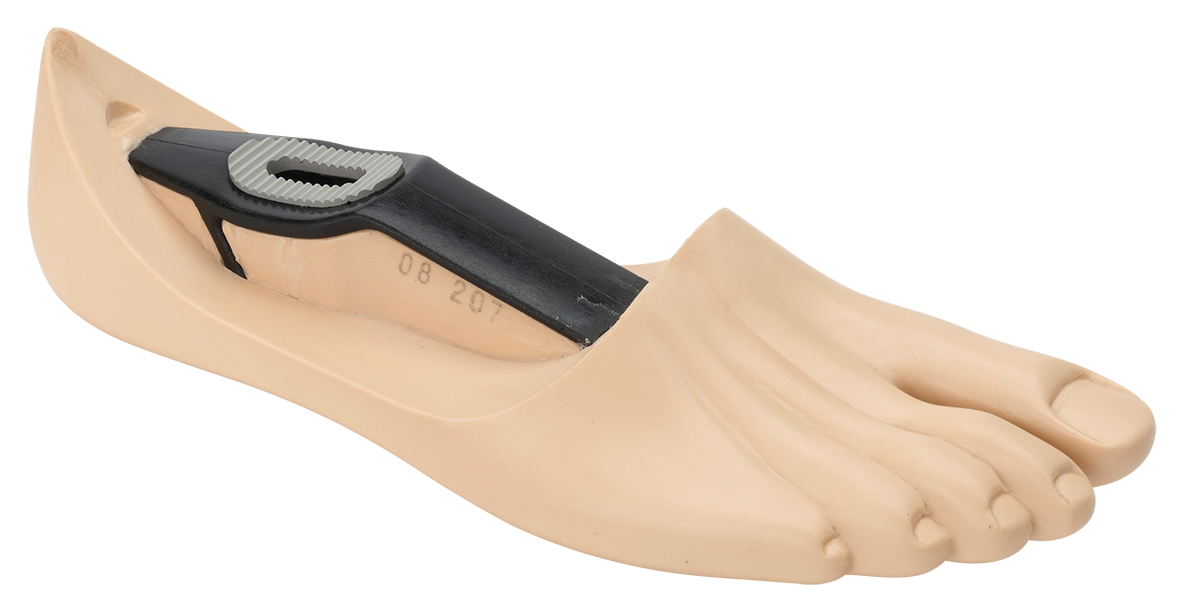Multiflex Standard
The Multiflex Standard foot is a multi-axial prosthetic foot. A multi-axial foot is durable and helps increase stability on uneven surfaces and uneven terrain. The foot and ankle joint provide the activity level 2 user with comfortable multi-axial motion (moving up/down or side-to-side), which enhances stability.
The low-profile design with sandal toe allows for a more natural appearance.
Axial feet are based in biomimetic design, mimicking normal ankle motion.
This product pairs with Multiflex Ankle and other ankle pairings.
- Activity level 1
- Activity level 2
- Suitable for outdoor use
Multiflex – Standard Clinical Evidence Reference
Clinical Outcomes using Multiflex feet
-
Safety
- Low stiffness at weight acceptance leads to early foot-flat and greater stability for lower mobility patients14
- No loss of stability during standing with Multiflex than fixed ankle/foot15
- Easier to walk on uneven ground with Multiflex than fixed ankle/foot15,16
- Easier to walk up a slope with Multiflex than fixed ankle/foot15
-
Mobility
- Little to no difference in gait mechanics compared to flexible, “energy storing” prosthetic feet17
- Increased prosthetic ankle range-of-motion with Multiflex compared to fixed ankle/foot15,16,18-20
- Increased prosthetic ankle power with Multiflex compared to fixed ankle/foot for bilateral users16
- Prosthetic rollover shape closer to natural biomechanics than fixed ankle/foot18
- Bilateral users can walk longer distances and report “smoother” gait with Multiflex compared to fixed ankle/foot16
- Benefits in mobility for bilateral users15,16,18,19
-
Residual Limb Health
- Equivalent socket comfort to higher technology, energy-storing feet21
-
Loading symmetry
- Improved stance phase timing symmetry with Multiflex compared to fixed ankle/foot20
- Reduced sound limb loading with Multiflex compared to fixed ankle/foot20
-
User satisfaction
- Majority of users rate Multiflex as either “good” or “acceptable”22 and bilateral users prefer Multiflex to fixed ankle/foot16
References
-
Full Reference Listing
-
Moore R.
Patient Evaluation of a Novel Prosthetic Foot with Hydraulic Ankle Aimed at Persons with Amputation with Lower Activity Levels. JPO J Prosthet Orthot 2017; 29: 44–47.
-
Moore R.
Effect on Stance Phase Timing Asymmetry in Individuals with Amputation Using Hydraulic Ankle Units. JPO J Prosthet Orthot 2016; 28: 44–48.
-
Buckley JG, De Asha AR, Johnson L, et al.
Understanding adaptive gait in lower-limb amputees: insights from multivariate analyses. J Neuroengineering Rehabil 2013; 10: 98.
-
Sedki I, Moore R.
Patient evaluation of the Echelon foot using the Seattle Prosthesis Evaluation Questionnaire. Prosthet Orthot Int 2013; 37: 250–254.
-
Rogers JP, Strike SC, Wallace ES.
The effect of prosthetic torsional stiffness on the golf swing kinematics of a left and a right-sided trans-tibial amputee. Prosthet Orthot Int 2004; 28: 121–131.
-
Kobayashi T, Orendurff MS, Boone DA.
Dynamic alignment of transtibial prostheses through visualization of socket reaction moments. Prosthet Orthot Int 2015; 39: 512–516.
-
Wright D, Marks L, Payne R.
A comparative study of the physiological costs of walking in ten bilateral amputees. Prosthet Orthot Int 2008; 32: 57–67.
-
Vanicek N, Strike SC, Polman R.
Kinematic differences exist between transtibial amputee fallers and non-fallers during downwards step transitioning. Prosthet Orthot Int 2015; 39: 322–332.
-
Barnett C, Vanicek N, Polman R, et al.
Kinematic gait adaptations in unilateral transtibial amputees during rehabilitation. Prosthet Orthot Int 2009; 33: 135–147.
-
Emmelot C, Spauwen P, Hol W, et al.
Case study: Trans tibial amputation for reflex sympathetic dystrophy: Postoperative management. Prosthet Orthot Int 2000; 24: 79–82.
-
Boonstra A, Fidler V, Eisma W.
Walking speed of normal subjects and amputees: aspects of validity of gait analysis. Prosthet Orthot Int 1993; 17: 78–82.
-
Datta D, Harris I, Heller B, et al.
Gait, cost and time implications for changing from PTB to ICEX® sockets. Prosthet Orthot Int 2004; 28: 115–120.
-
De Castro MP, Soares D, Mendes E, et al.
Center of pressure analysis during gait of elderly adult transfemoral amputees. JPO J Prosthet Orthot 2013; 25: 68–75.
-
Major MJ, Scham J, Orendurff M.
The effects of common footwear on stance-phase mechanical properties of the prosthetic foot-shoe system. Prosthet Orthot Int 2018; 42: 198–207.
-
McNealy LL, A. Gard S.
Effect of prosthetic ankle units on the gait of persons with bilateral trans-femoral amputations. Prosthet Orthot Int 2008; 32: 111–126.
-
Su P-F, Gard SA, Lipschutz RD, et al.
Gait characteristics of persons with bilateral transtibial amputations. J Rehabil Res Dev 2007; 44: 491–502.
-
Boonstra A, Fidler V, Spits G, et al.
Comparison of gait using a Multiflex foot versus a Quantum foot in knee disarticulation amputees. Prosthet Orthot Int 1993; 17: 90–94.
-
Gard SA, Su P-F, Lipschutz RD, et al.
The Effect of Prosthetic Ankle Units on Roll-Over Shape Characteristics During Walking in Persons with Bilateral Transtibial Amputations. J Rehabil Res Dev 2011; 48: 1037.
-
Major MJ, Stine RL, Gard SA.
The effects of walking speed and prosthetic ankle adapters on upper extremity dynamics and stability-related parameters in bilateral transtibial amputee gait. Gait Posture 2013; 38: 858–863.
-
Van der Linden M, Solomonidis S, Spence W, et al.
A methodology for studying the effects of various types of prosthetic feet on the biomechanics of trans-femoral amputee gait. J Biomech 1999; 32: 877–889.
-
Graham LE, Datta D, Heller B, et al.
A comparative study of conventional and energy-storing prosthetic feet in high-functioning transfemoral amputees. Arch Phys Med Rehabil 2007; 88: 801–806.
-
Mizuno N, Aoyama T, Nakajima A, et al.
Functional evaluation by gait analysis of various ankle-foot assemblies used by below-knee amputees. Prosthet Orthot Int 1992; 16: 174–182.
-
Multiflex Standard Documentation


